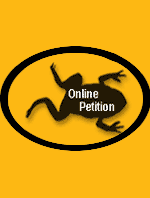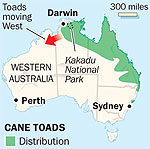

Get your Stop The Toad
bumper sticker here ..

Web Masters:
Use this button to
link back to this site.

Toad MediaMEDIA TimesOnLineOctober 06 2006London Times - Volunteer army tries to halt toxic toad invasionFrom Bernard Lagan in Sydneyhttp://www.timesonline.co.uk/article/0,,3-2391312.html After a 1,800-mile (2,885km) journey across the Outback, the toads, which can weigh more than one kilogram (2¼lb) and grow up to 23cm (9in) long, have settled in their millions in the World Heritagelisted Kakadu National Park. For the next month, scores of volunteers will attempt to thwart the westward march, killing as many as possible. There they have decimated native populations of goannas, the native Australian monitor lizard that grows up to 160cm (5ft) long, and northern quolls, a native rat-like creature that grows to the size of a cat. Such has been their effect that quolls are being transported to outer islands to try to preserve their numbers. The toads secrete a lethal venom, which paralyses and kills any animal or reptile, including crocodiles and dingos, that tries to eat them. They have no predators in Australia and female toads spawn twice a year, producing up to 35,000 eggs a time. Studies conducted at Sydney University show that the toads are evolving longer front legs to speed their conquest of the Outback. “Their impact is catastrophic,” said Tony Griffiths, a research Fellow at Charles Darwin University in Darwin. “What is going to be interesting in five years’ time is whether those populations [of now endangered native species] will still be able to persist at very low levels.” Naturalists predict another unexpected result of the cane toad explosion: a rapid growth in the crocodile population of northern Australia. Goanna numbers along rivers southeast of Darwin are now so low that one of their favourite foods — crocodile eggs — are being left untouched. Up to 95 per cent of crocodile eggs are usually eaten by goannas. Last month scientists found that this had dropped to about 20 per cent. Other studies show that endangered turtle species are also benefiting from the survival of eggs that traditionally would have been eaten by goannas. The state of Western Australia is the only area to have been spared the toads so far. However, they have been sighted less than 100 km (60 miles) from its eastern border. Dennis Beros, one of the cull organisers, said: “The plan is to drive the toads back each year until a biological king-hit can be found to put the toad genie back in its bottle.”
|
Supported by |
 |
Web Manager: Dave Graham - Web hosting & scripts: Alex Varlakov http://ozup.com/ |


 THEIR
poison kills with gruesome efficiency and, after 70 years on the
march, they are a season away from conquering Australia from east
to west — almost wiping out once plentiful native animals.
THEIR
poison kills with gruesome efficiency and, after 70 years on the
march, they are a season away from conquering Australia from east
to west — almost wiping out once plentiful native animals.

















